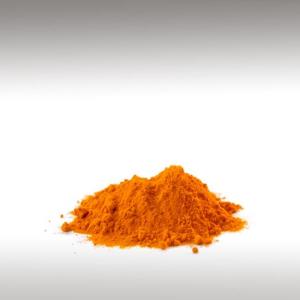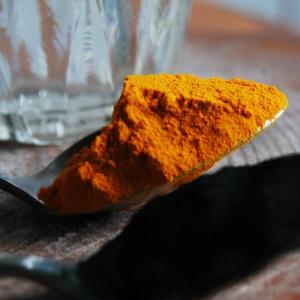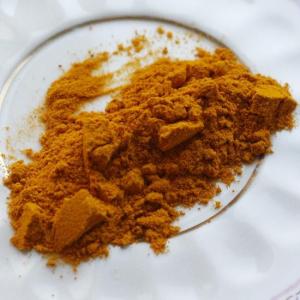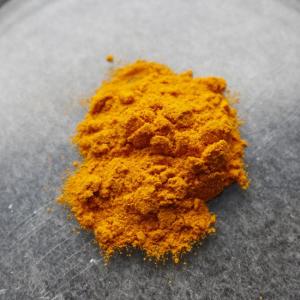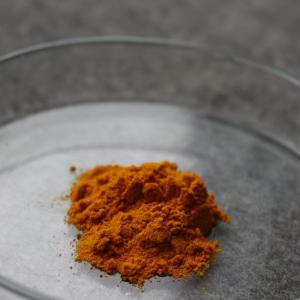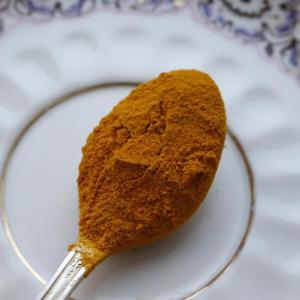
TURMERIC ROOT POWDER (CURCUMA LONGA) - INGREDIENTS

BASE / GENERAL DATA
Information submited: March 30, 2015 Modified: June 4, 2018 By: OperaDreamhouse
Turmeric (Curcuma Longa) is a rhizomatous herbaceous perennial plant of the Ginger family, Zingiberaceae. It is native in southwest India, and needs temperatures between 20 and 30°C and a considerable amount of annual rainfall to thrive.
Turmeric is a perennial herbaceous plant, which reaches up to 1 m tall. Highly branched, yellow to orange, cylindrical, aromatic rhizomes are found.
Not used fresh, the rhizomes are boiled for about 30 - 45 minutes and then dried in hot ovens, after which they are ground into a deep-orange-yellow powder commonly used as a spice.
The name of the genus, Curcuma is from an Arabic name of both Saffron and Turmeric (see Crocus). The name appears to derive from Middle English/early modern English. There may be Latin origin, Terra Merita (Merited Earth).
Turmeric is considered auspicious and holy in India and has been used in various Hindu ceremonies for Millennia. It remains popular in India for wedding and religious ceremonies.
The Turmeric paste is applied by friends to the bodies of the couple. This is said to soften the skin, but also colors them with the distinctive yellow hue that gives its name to wedding ceremony.
Turmeric has played an important role in Hindu spiritualism.
Turmeric is a perennial herbaceous plant, which reaches up to 1 m tall. Highly branched, yellow to orange, cylindrical, aromatic rhizomes are found.
Not used fresh, the rhizomes are boiled for about 30 - 45 minutes and then dried in hot ovens, after which they are ground into a deep-orange-yellow powder commonly used as a spice.
The name of the genus, Curcuma is from an Arabic name of both Saffron and Turmeric (see Crocus). The name appears to derive from Middle English/early modern English. There may be Latin origin, Terra Merita (Merited Earth).
Turmeric is considered auspicious and holy in India and has been used in various Hindu ceremonies for Millennia. It remains popular in India for wedding and religious ceremonies.
The Turmeric paste is applied by friends to the bodies of the couple. This is said to soften the skin, but also colors them with the distinctive yellow hue that gives its name to wedding ceremony.
Turmeric has played an important role in Hindu spiritualism.
The robes of the Hindu monks were traditionally colored with a yellow dye made of Turmeric. Because of its yellow-orange coloring, Turmeric was associated with the sun or the Thirumal in the mythology of ancient Tamil religion.
Yellow is the color of the Solar Plexus Chakra which in traditional Tamil Siddha medicine is an energy center. Orange is the color of the Sacral Chakra.
Chemical structure:
One active ingredient is Curcumin, which has a distinctly earthy, slightly bitter, slightly hot peppery flavor and a mustardy smell.
The most important chemical components of Turmeric are a group of compounds called Curcuminoids, which include Curcumin (diferuloylmethane), Demethoxycurcumin, and Bisdemethoxycurcumin.
Chemical structure:
One active ingredient is Curcumin, which has a distinctly earthy, slightly bitter, slightly hot peppery flavor and a mustardy smell.
The most important chemical components of Turmeric are a group of compounds called Curcuminoids, which include Curcumin (diferuloylmethane), Demethoxycurcumin, and Bisdemethoxycurcumin.
The best-studied compound is Curcumin, which constitutes 3.14% (on average) of powdered Turmeric.
In addition, other important volatile oils include Turmerone, Atlantone, and Zingiberene.
Some general constituents are Sugars, Proteins, and Resins.

SPIRITUAL PRACTISES DATA
Information submited: September 19, 2015 Modified: June 4, 2018 By: OperaDreamhouse
Ancient Indians understood Turmeric to be the physical essence of the Divine Mother - a botanical embodiment of compassion and healing.

MEDICINE / HEALTH DATA
Information submited: September 19, 2015 Modified: June 4, 2018 By: OperaDreamhouse
It turns out that even modern science now confirm that this "Curry" spice has therapeutic properties relevant to well over 600 different health conditions, and may therefore bestow on those who take it significant protection from many common causes of human suffering.
Some of the more amazing examples are its ability to reverse aspects of dementia (Alzheimer's disease), replace Prozac, prevent type 2 diabetes, producecardiovascular benefits as significant as exercise, including preventing post - bypass heart attack by 56%, heal thediabetic liver, kill lethal pancreatic cancer,and help kick painkillers to the curb for osteoarthritis andrheumatoid arthritis.
Some of the more amazing examples are its ability to reverse aspects of dementia (Alzheimer's disease), replace Prozac, prevent type 2 diabetes, producecardiovascular benefits as significant as exercise, including preventing post - bypass heart attack by 56%, heal thediabetic liver, kill lethal pancreatic cancer,and help kick painkillers to the curb for osteoarthritis andrheumatoid arthritis.

BEAUTY / COSMETICS DATA

FOOD / COOKING DATA
COMMENTS
No comments.
Newest mixtures containing Turmeric Root Powder (Curcuma Longa):

Fortified drink for our body and brain
May 21, 2015

Base Golden milk masala
May 12, 2015


